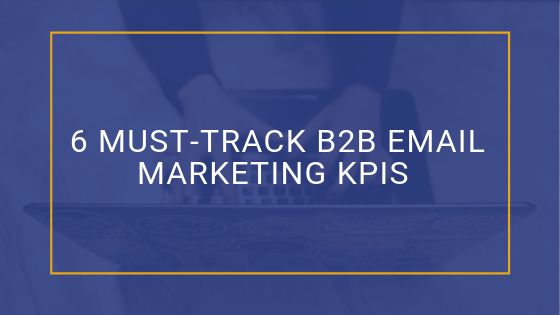Whether you’re a seasoned marketing pro or an email novice, check out the list of our top B2B email marketing KPIs we like to track. But before we dive into the metrics, we need to touch on one major email marketing necessity, goals.
Email Marketing Goals
You should know by now that random acts of marketing (executing marketing tactics that aren’t part of an overarching strategy) are a major don’t in our book and that definitely applies to emails. You might be thinking, “It’s just an email.” And in a sense, you’re right. However, all email communication whether it be a newsletter or a simple follow up email post-download needs to be part of a greater digital marketing strategy.
Learn all about Lake One’s Digital Strategy here.
Okay, so how do you go from the big picture down to your email campaigns? You break it down email by email.
HubSpot recommends doing a quick gut check before you send your next email by asking yourself these questions. What is the goal of my email marketing? Is it to grow my subscriber database? Generate more leads? To convert more existing leads into customers?

Once you have your goal(s) determined, you’re ready to figure out which metrics you need to track. Read on for our top 6 fav B2B Email Marketing KPIs.
Need help goal setting? Download our SMART Goals template.
#1. Bounce Rate
What is bounce rate? Bounce rate is the percentage of emails that could not be successfully delivered to the email recipient’s inbox.
Why we track bounce rate: Emails can bounce for several reasons and fall into two categories, “hard” and “soft”. Soft bounces are temporary problems with delivery like issues with an email client’s server. Hard bounces are permanent problems such as a nonexistent email address and will never be delivered.
Okay, so an email can’t be delivered, how does that affect you? Our friends at HubSpot say contact list cleanup is a must and we agree. All hard bounces should be removed from your list immediately because internet service providers (ISPs) use bounce rates as one of the key factors to determine an email sender’s reputation. Too many bounces = Spammer when it comes to ISPs.
#2. Open Rate
What is open rate? Open rate is the percentage of recipients that open a given email.
Why we track open rate: Recipients can’t convert if they aren’t opening your emails, so the open rate can be a great place to start for optimization. We have to disclose though, not everyone is a fan of tracking open rate because it can be an unreliable metric. An email only counts as opened if the recipient also receives all embedded images within that email. Image blocking is an option via email clients- it’s definitely a possibility your number is off.
So all of the above aside, we still like to keep open rate on our radar, especially when optimizing subject lines and using it comparatively.
#3. Click-Through-Rate
What is Click-through-rate? CTR is the percentage of email recipients who clicked on one or more links in an email. We often refer to the links as the Call-to-Action (CTA) of the email.
Why we track CTR: CTR is a great indicator of how your email is performing and if your content is resonating with your personas. Are recipients actually clicking on the links that you want them to click on? According to Campaign Monitor, the average click-through rate for most campaigns is slightly over 4%. Here are some tips on how to optimize your followup email CTAs for a higher CTR.
#4. Conversion Rate
What is conversion rate? Conversion rate is the percentage of email recipients who clicked on an email CTA and completed the desired action. Think completing a form, signing up for a free trial, making a purchase, etc.
Why we track conversion rate: Conversion rate is the money maker! Both figuratively and quite literally in some instances. The first step in email marketing is getting the user to click on your link in the email and the second is getting them to convert. This is a major metric in determining if you are meeting your goals.
Lead to MQL/Customer Conversion Rate
Depending on your email campaign goals you can really drill down when it comes to conversion rate. It can also spin off into other metrics such as Lead to Marketing Qualified conversion rate and Lead to Customer conversion rates.
#5. ROI
What is B2B Email Marketing ROI? ROI is the overall return on investment for your B2B email marketing campaign.
Why we track ROI: ROI is a KPI staple. Just like any other initiative within your company, you need to track ROI. Are you making money? Are your marketing efforts helping the bottom line? ROI analysis can point out areas of opportunity and areas that are burning cash.
While we’re talking about KPIs, are you tracking your sales and marketing team alignment? Here’s some more info.
#6. Unsubscribe Rate
What is Unsubscribe Rate? Unsubscribe rate is the rate at which email recipients are unsubscribing from receiving email communication from your company.
Why we track unsubscribe rate: Unsubscribes alone shouldn’t be the only indicator you review for email performance; however, if your unsubscribes are high, check it out! Perhaps your email is too aggressive, your customers have outgrown you, or your persona messaging is off.
Whatever the reason, high unsubscribe rates are like a big flashing light saying, “Change needed here.”

Words to the Wise
It’s easy to get lost in the numbers and become hyper-focused on the KPIs of B2B email, but here are few things to keep in mind.
- Keep it in perspective. Don’t rest solely on percentages. Make sure to look at how many recipients are contributing to the data before you go optimization crazy.
- Optimize. And then Optimize again. Perhaps it goes without saying, but if you see a number you don’t like, optimize! Emails are perfect candidates for testing.
- Give it time. You want to give your email campaign time to do its thing. Rapid-fire changes aren’t helpful because it muddies the waters of what’s actually contributing to the change.



